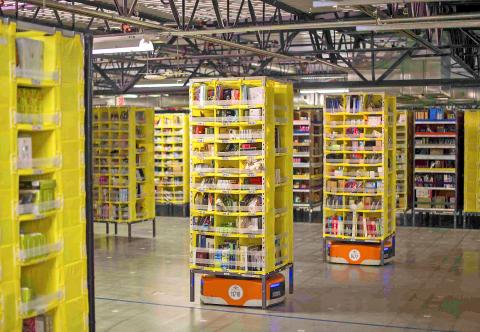A year ago, Amazon.com workers like 34-year-old Rejinaldo Rosales walked the aisles each shift to find each item a customer ordered and prepare it for shipping.
Now the e-commerce giant boasts that it has boosted efficiency by deploying more than 15,000 wheeled robots to crisscross the floors of its biggest warehouses and deliver stacks of toys, books and other products to employees.
“We pick two to three times faster than we used to,” Rosales said during a break from sorting merchandise into bins at Amazon’s massive distribution center in Tracy, California. “It’s made the job a lot easier.”

Photo: Reuters
Amazon.com Inc, which expected to face its single biggest day of online shopping yesterday, has invested heavily this year in upgrading and expanding its distribution network, adding new technology, opening more shipping centers and hiring 80,000 seasonal workers to meet the coming onslaught of holiday orders.
Amazon says it processed orders for 36.8 million items on the Monday after Thanksgiving last year, and it expected “Cyber Monday” to be even busier this year.
Chief executive Jeff Bezos vows to one day deliver packages by drone, but that technology is not ready yet. Even so, Amazon does not want a repeat of last year, when some customers were disappointed by late deliveries attributed to ice storms in the US Midwest and last-minute shipping troubles at both UPS Inc and FedEx Corp. Meanwhile, the company is facing tough competition from rivals like Google Inc and eBay Inc, and traditional retailers are offering more online services.
Amazon has forecast revenue of US$27.3 billion to US$30.3 billion for the holiday quarter, up 18 percent from last year, but less than Wall Street had expected.
However, Amazon has invested billions of US dollars in its shipping network, and its reliability is a big selling point to customers, Piper Jaffray investment analyst Gene Munster wrote in a note to clients on Friday last week. He thinks Amazon’s forecast is conservative.
The Seattle-based company now has 109 shipping centers around the globe. The Tracy facility is one of 10 in which Amazon has deployed the robots, using technology acquired when the company bought robot-maker Kiva Systems Inc in 2012, said Dave Clark, Amazon’s senior vice president for operations, who gave reporters a tour on Sunday.
More than 1,500 full-time employees work at the center. They are joined by about 3,000 robots, gliding swiftly and quietly around the warehouse. The robots navigate by scanning coded stickers on the floor, following digital commands that are beamed wirelessly from a central computer.
The system uses bar codes to track which items are on each shelf, so a robot can fetch the right shelves for each worker as orders come in.
The robots are expected to cut the Tracy center’s operating costs by 20 percent, Clark said. However, he was quick to say that they will not eliminate jobs.
“Our focus is all about building automation that helps people do their jobs better,” he said, adding that workers are needed for more complex tasks such as shelving, packing and checking for damaged items.

PATENTS: MediaTek Inc said it would not comment on ongoing legal cases, but does not expect the legal action by Huawei to affect its business operations Smartphone integrated chips designer MediaTek Inc (聯發科) on Friday said that a lawsuit filed by Chinese smartphone brand Huawei Technologies Co (華為) over alleged patent infringements would have little impact on its operations. In an announcement posted on the Taiwan Stock Exchange, MediaTek said that it would not comment on an ongoing legal case. However, the company said that Huawei’s legal action would have little impact on its operations. MediaTek’s statement came after China-based PRIP Research said on Thursday that Huawei filed a lawsuit with a Chinese district court claiming that MediaTek infringed on its patents. The infringement mentioned in the lawsuit likely involved

Taipei is today suspending work, classes and its US$2.4 trillion stock market as Typhoon Gaemi approaches Taiwan with strong winds and heavy rain. The nation is not conducting securities, currency or fixed income trading, statements from its stock and currency exchanges said. Authorities had yesterday issued a warning that the storm could affect people on land and canceled some ship crossings and domestic flights. Taiwan Semiconductor Manufacturing Co (TSMC, 台積電) expects its local chipmaking fabs to maintain normal production, the company said in an e-mailed statement. The main chipmaker for Apple Inc and Nvidia Corp said it has activated routine typhoon alert

GROWTH: TSMC increased its projected revenue growth for this year to more than 25 percent, citing stronger-than-expected demand for AI devices and smartphones The Taiwan Institute of Economic Research (TIER, 台灣經濟研究院) yesterday raised its forecast for Taiwan’s GDP growth this year from 3.29 percent to 3.85 percent, as exports and private investment recovered faster than it predicted three months ago. The Taipei-based think tank also expects that Taiwan would see a 8.19 percent increase in exports this year, better than the 7.55 percent it projected in April, as US technology giants spent more money on artificial intelligence (AI) infrastructure and development. “There will be more AI servers going forward, but it remains to be seen if the momentum would extend to personal computers, smartphones and

Catastrophic computer outages caused by a software update from one company have once again exposed the dangers of global technological dependence on a handful of players, experts said on Friday. A flawed update sent out by the little-known security firm CrowdStrike Holdings Inc brought airlines, TV stations and myriad other aspects of daily life to a standstill. The outages affected companies or individuals that use CrowdStrike on the Microsoft Inc’s Windows platform. When they applied the update, the incompatible software crashed computers into a frozen state known as the “blue screen of death.” “Today CrowdStrike has become a household name, but not in